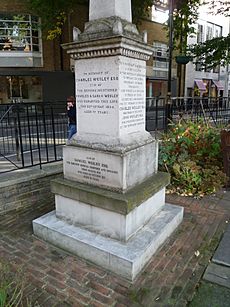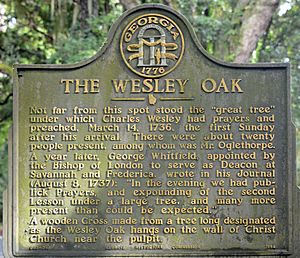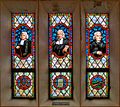Charles Wesley facts for kids
Quick facts for kids Charles Wesley |
|
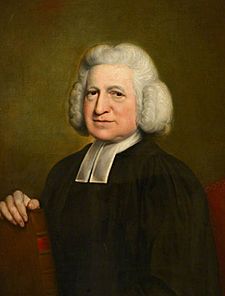 Portrait by John Russell |
|
| Born | 18 December 1707 in Epworth, Lincolnshire, Great Britain |
|---|---|
| Died | 29 March 1788 (aged 80) in London, Great Britain |
| Church | Church of England |
| Education | Westminster School and Christ Church, Oxford |
| Congregations served | New Room, Bristol |
| Spouse | Sarah Wesley (née Gwynne) |
| Children | 8, including Samuel Wesley |
| Parents | Samuel and Susanna Wesley |
Charles Wesley (born December 18, 1707 – died March 29, 1788) was an important English leader of the Methodist movement. He was famous for writing over 6,500 hymns during his life. Some of his most well-known hymns include "And Can It Be", "Christ the Lord Is Risen Today", "Love Divine, All Loves Excelling", and the Christmas carol "Hark! The Herald Angels Sing".
Charles Wesley was born in Epworth, Lincolnshire. His father, Samuel Wesley, was a church leader and poet. His mother was Susanna. Charles was the younger brother of John Wesley, who founded the Methodist movement. He was also the brother of Samuel Wesley the Younger. Later in life, Charles became the father of the musician Samuel Wesley.
He studied at Oxford University, just like his brothers. In 1729, he started a prayer group with other students called the "Holy Club". His brother John and George Whitefield later joined this group. Charles became a church leader in 1735 and traveled to Georgia in America with John. They returned a year later.
After important religious experiences in 1738, the Wesley brothers traveled all over Britain. They spread the Methodist revival by preaching and singing hymns. In 1749, Charles married Sarah Gwynne. From 1756, he mostly worked in Bristol and later in London. Even though they were close, Charles and John sometimes disagreed. Charles strongly believed that Methodism should stay connected to the Church of England.
Contents
Biography
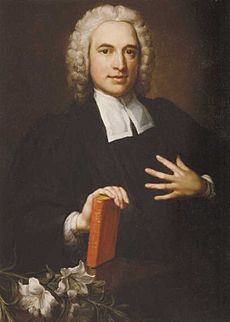
Early Life and Education
Charles Wesley was the eighteenth child of Susanna Wesley and Samuel Wesley. He was born in Epworth, England, where his father was a church leader. In 1716, when he was 8 years old, Charles went to Westminster School. His brother Samuel was a teacher there.
He later went to Christ Church, Oxford, a college at Oxford University. At Oxford, Charles started a prayer group with his friends in 1727. His older brother, John, joined in 1729 and soon became the leader. The group focused on studying the Bible and living a very religious life. Other students made fun of them, calling them the "Holy Club" or "the Methodists". This was because they were very organized and detailed in their Bible study and daily lives. George Whitefield, who would also become a famous preacher, joined their group. Charles finished his degree in 1732. He became a priest in the Anglican orders in September 1735. His father passed away that same year.
Journey to America
On October 14, 1735, Charles and his brother John sailed from England to Savannah in the Georgia Colony. They went there because the governor, James Oglethorpe, asked them to. Charles was given the job of Secretary of Indian Affairs. While John stayed in Savannah, Charles became a chaplain at Fort Frederica on St. Simon's Island. He arrived there on March 9, 1736. Things did not go well for him there, and many settlers did not accept him. In July 1736, Charles was sent back to England with messages for the colony's leaders. He left on August 16, 1736, and never returned to Georgia.
His Ministry and Preaching
In 1738, both Wesley brothers had very important religious experiences. Charles had his conversion on May 21, and John had a similar experience just three days later. This experience gave Charles new energy to share his faith with ordinary people. It was around this time that he started writing the beautiful hymns he is known for.
In January 1739, he became a curate at St Mary's Church, Islington. But he had to leave because church leaders did not like his energetic preaching. Later that year, since they were not welcome in many churches, the Wesley brothers began preaching to large crowds outdoors. They were inspired by George Whitefield, who was already preaching to many people in open fields.
From 1740, John and Charles led the Methodist Revival. They traveled all over Britain and Ireland, sharing their faith. Many Anglican church leaders opposed them, especially when their appointed lay preachers started preaching without permission. Charles faced angry crowds in places like Wednesbury and Sheffield in 1743.
After 1756, Charles stopped traveling long distances due to illness. He mostly moved between Bristol and London. In his later years, Charles strongly believed that Methodism should remain part of the Church of England. He was upset when his brother John started ordaining priests to serve in America.
Marriage and Family Life
In April 1749, Charles married Sarah Gwynne (1726–1822), who was much younger than him. She was also known as Sally. Sarah was the daughter of Marmaduke Gwynne, a wealthy Welsh judge who had become a Methodist. They moved into a house in Bristol in September 1749. Sarah traveled with the brothers on their journeys around Britain until at least 1753.
In 1771, Charles got another house in London and moved there with his oldest son. By 1778, the whole family had moved from Bristol to the London house in Marylebone. They lived there until Charles died. The house in Bristol still stands today.
Only three of their children lived past infancy: Charles Wesley junior (1757–1834), Sarah Wesley (1759–1828), and Samuel Wesley (1766–1837). Both Samuel and Charles junior were amazing musical talents from a young age. They became organists and composers, like their father. Charles junior worked as the personal organist for the Royal Family. Samuel became one of the most skilled musicians in the world and is sometimes called "the English Mozart." Samuel Wesley's son, Samuel Sebastian Wesley, was also a very important British composer in the 1800s.
Death and Burial
Before he died, Charles Wesley asked the church leader of St Marylebone Parish Church, John Harley, to bury him in the churchyard. He said, "Sir, whatever the world may say of me, I have lived, and I die, a member of the Church of England."
Charles Wesley died on March 29, 1788, in London, at the age of 80. Six Church of England clergymen carried his body to the church. There is a memorial stone for him in the gardens on Marylebone High Street, near where he was buried. One of his sons, Samuel, later became the organist at that church.
Hymns and Other Works
Charles Wesley was an incredibly productive hymnwriter. He wrote thousands of hymns. Some of his hymn collections published during his lifetime include Hymns on God's Everlasting Love (1741, 1742) and Hymns on the Lord's Supper (1745). He also wrote hymns for major Christian holidays.
His hymns are known for their strong Christian teachings. They often talk about God's love for everyone. They also use many ideas from the Bible and other writings. His hymns have had a big impact not only on Methodism but also on Christian worship and beliefs around the world.
Charles Wesley also wrote other types of poetry, including letters, poems about sad events, and political poems. A large collection of his and John Wesley's poems was published in 13 volumes between 1868 and 1872.
His religious experience in 1738 greatly influenced his beliefs, especially about the power of the Holy Spirit. This change was most clear in the hymns he wrote after that year. In one hymn, he wrote about the Holy Spirit living within us, guiding us, and inspiring good thoughts. He believed the Holy Spirit helps us and plants good desires in our hearts.
Famous Hymns
Charles Wesley wrote the words to between 6,500 and 10,000 hymns. Many of them are still sung today. Here are some of his most famous ones:
- "Arise, My Soul, Arise" (Words)
- "And Can It Be That I Should Gain?" (Words)
- "Christ the Lord Is Risen Today" (Words)
- "Christ, Whose Glory Fills the Skies" (Words)
- "Come, O Thou Traveler Unknown" (Words)
- "Come, Thou Long Expected Jesus" (Words)
- "Depth of Mercy, Can it Be" (Words)
- "Father, I Stretch My Hands to Thee" (Words)
- "Hail the Day That Sees Him Rise" (Words)
- "Hark! The Herald Angels Sing" (Words)
- "Jesus, Lover of My Soul" (Words)
- "Jesus, The Name High Over All" (Words)
- "Lo! He Comes with Clouds Descending" (Words)
- "Love Divine, All Loves Excelling" (Words)
- "O for a Heart to Praise My God" (Words)
- "O for a Thousand Tongues to Sing" (Words)
- "O Thou Who Camest from Above" (Words)
- "Rejoice, the Lord is King" (Words)
- "Soldiers of Christ, Arise" (Words)
- "Thou Hidden Source of Calm Repose" (Words)
- "Ye Servants of God" (Words)
You can find the words to many more of Charles Wesley's hymns on Wikisource.
About 150 of his hymns are in the Methodist hymn book Hymns and Psalms. Many of his hymns have been translated into other languages. They form the basis for Methodist hymn books around the world.
Psalms in Hymns
Wesley's hymns are also special because they often explain parts of the Bible. He also rewrote many of the Psalms from the Bible into hymns. He often included ideas about Jesus in his Psalm hymns. This was sometimes a topic of discussion, even within his own family.
Legacy
Charles Wesley is still remembered for his work on St. Simon's Island, Georgia. In 1950, the United Methodist Church opened a Christian retreat center there called Epworth by the Sea. It was named in honor of Charles and John's birthplace.
He is honored in the Calendar of Saints by the Evangelical Lutheran Church in America on March 2, along with his brother John. The Wesley brothers are also remembered on March 3 in the Calendar of Saints of the Episcopal Church. Charles is remembered on March 29 by The Order of Saint Luke.
The Church of England also remembers Charles (with John) on May 24 with a special celebration.
Because his hymns are still so popular, the Gospel Music Association recognized his contributions to gospel music in 1995. They put his name in the Gospel Music Hall of Fame.
Wesley's hymns are used not only in Methodist churches but also in many other Protestant churches. Even the Roman Catholic Church has adopted some of his hymns. He wrote two of the very famous "Great Four Anglican Hymns:" "Hark! The Herald Angels Sing" and "Lo! He Comes With Clouds Descending."
Tercentenary Celebration
May 24, 2007, was celebrated as the 300th anniversary of Wesley's birth. Many events were held across England, even though he was actually born in December 1707. May 24 is known to Methodists as Aldersgate Day. It remembers the important spiritual awakenings of Charles and then John Wesley in 1738.
In November 2007, An Post, the Irish Post Office, released a special stamp to celebrate the 300th anniversary of Wesley's birth.
Images for kids
-
A statue of Wesley at St. Matthew's Church in Bristol, by Arnold Wathen Robinson.
-
Stained glass window showing Bach, Wesley, and Handel at Cambridge Road Methodist Church, Birmingham.
-
Stained glass of Charles Wesley, John Wesley, and Francis Asbury at Lake Junaluska.
-
A statue by Frederick Brook Hitch at the New Room, Bristol.
See also
 In Spanish: Charles Wesley para niños
In Spanish: Charles Wesley para niños



